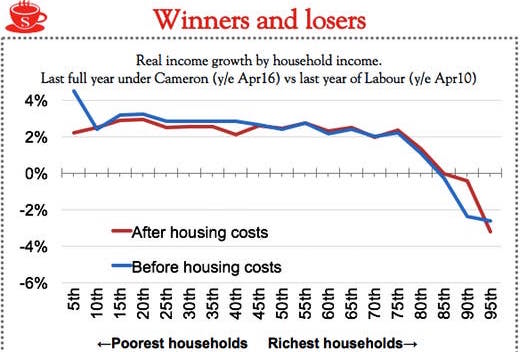Was the general election a vote against austerity? I was on the Today programme this morning to discuss this point, and in the course of the interview said that the lowest-paid did best under the Cameron years. This raised some degree of incredulity from Twitter, reported by Huffington Post. What planet am I on? I thought I’d answer.
The Cameron years were tough, especially for those on welfare. But the aim was always to make people better-off by moving them into work. David Cameron did cut tax for employers, with corporation tax far lower. Liam Byrne, with whom I was on the Today programme, said that companies hoarded cash – but he didn’t say that they also employed a lot more people than they used to. So while 442,000 public sector positions were cut, 3.51 million private sector positions were created: the economy created eight jobs for every one shed by government.

This matters because government cannot create jobs: every penny paid to a public sector worker needs to be taken from the economy in tax. Which means less cash to hire people. The best the state can do is move jobs, from the private sector into the public sector. But because the government is quite inefficient, it doesn’t do this terribly well. Austerity means government shedding jobs, yes. But done properly, the private sector will create three or four jobs for every one shed by the government. As it was to prove this time, except Camerom upped the ratio to eight. In fact, David Cameron created jobs at a faster rate than any postwar Prime Minister.
Then, Sarah Montague asked me, what type of jobs? Zero hours? A popular retort, but most of the jobs created are full-time jobs

So a reforming Tory government had to cut state spending – but they also cut tax for employers (powering the job booms) reformed welfare (moving more people into work) and then cut the tax for the low-paid. You will be familiar with graphs showing that the effect of government spending cuts hurts the poorest hardest, but these graphs never factor in what is – for Conservatives – the other side of the coin, the employment boom. So add the two together: welfare cuts with the jobs increase, and how did people do? The below graph compares incomes in 2015-16 with the last full year under Labour, 2009-10.

Liam Byrne was wittering on this morning about a trickle-down theory of economics, which doesn’t exist. No serious economist has ever espoused a trickle-down theory and anyway, as the above graph shows, the incomes of the best-paid fell the most under the Cameron years.
This is progressive Conservatism at work. It forced inequality to a 30-year low, in spite of having (as Liam Byrne notoriously put it) ‘no money left’. That’s not to say the last six years have been easy: that real incomes should rise by only 2pc in real terms over a seven-year period is an appalling state of affairs. But the government has no control over what people pay each other, beyond setting a minimum wage. The role of the state is to give help where it is needed, and try to stop economic exclusion. Everyone has had a tough time over the last seven years, but thanks to Tory policies the incomes of the lowest-paid have done a bit better than the average. Hence income inequality dropping to the lowest in a generation.
During the election campaign, Conservatives said not a word about all this. Or anything else. Jeremy Corbyn was saying plenty about Labour policies and the Tories said all too little about David Cameron’s achievements. If the want to start winning arguments again, Tories had best rediscover David Cameron, his agenda and his legacy.







Comments